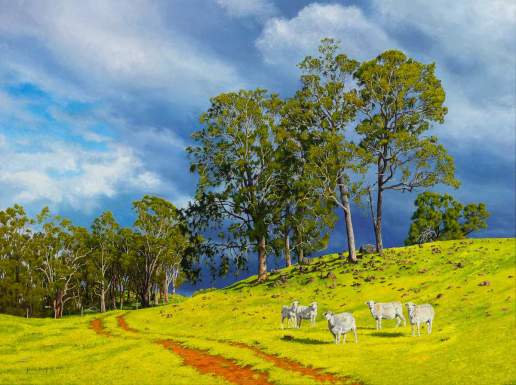This painting was commissioned as a gift for the property owner by his wife. I was fortunate to be given free reign on what the actual subject was so I was able to create a composition that I hoped would really hit the mark and one that I was excited about painting.
In researching I found out the recipient loves his trees and animals so I aimed to feature those elements strongly.
After exploring the whole property I settled on a view looking up a slope to a magnificent stand of trees. The rough vehicle track was a bonus, adding an entry way into the painting. What It didn’t have was any animals.
People always ask me about photography with regard to paintings – “Do you use photographs or go to the spot and paint?”. Well, the answer is both, depending on a lot of circumstances. Small simple works can be done on site in one sitting. Sometimes I will start on site, work frantically while the conditions and light are suitable and then complete the painting in the studio at my leisure. Larger paintings or formal compositions are created entirely as studio projects.
In this case it was all studio so I had to collect as much reference material from the site as I could. The most efficient way to do this is by taking photographs, lots of them. Not just one for the subject, but details of all the little interesting bits within and close-ups of what’s in shadows. It’s almost impossible to get all the visual info I want from one front-on photo. The compression in space of elements being reduced to two dimensions makes it really hard to distinguish the placement order of some things, such as branches. Side on reference photos give a different perspective that enables me to solve those compositional puzzles.
Added to that I’ll take notes on anything I can observe at the time such as position of the sun, colour impressions, compass direction of subject view, time and anything else I think may be useful when I’m at the easel.
Photos also enable me to easily play with compositions digitally until I have exactly what I want. In this case, the main view was created in Photoshop by stitching three photos together in a panorama and then superimposing other detail photos from another day with better lighting conditions over the top.
Also there were no sheep there so I had to import them. I had planned this in advance and spent an hour of more stalking sheep in a nearby paddock with my DSLR and a 400mm zoom lens. I knew which way the light had to fall on them so I had to keep moving around to get them in groups facing the right direction. Eventually I had dozens of sheep group photos for later reference.
Back in the studio I used Photoshop to create the grouping you see in the painting using two different photos and dropped them into the digital composition.
Next I looked at the winter afternoon mood I was trying to create. No sky shots taken on site were working for me so I decided to find something else. Luckily storms were moving through the area I live in so I took the opportunity to set up my camera on a tripod with a timer on the deck outside my studio and left it pointing skyward for several hours, automatically taking a shot every fifteen seconds. Later I went through the hundreds of resulting photos until I found the one that I thought was just right for the painting and dropped that into the composition. It fitted perfectly because on site I had noted what compass direction, what elevation angle and what time would be required to match the sky to the painting and I had used that information when setting up the camera.
So now I had everything needed for the composition and painting reference including some rocks that I had brought back to the studio for lichen and dirt colour references.
The last thing to do was to get the OK from the client which I did and I was able to get started. The digital composition reference was accessed via a laptop with attached external monitor next to my easel along with some black and white printouts. The painting process took about four weeks.
On a final note, the centre pregnant sheep facing the viewer was recognised by the client when they first saw the finished painting. They new exactly which sheep it was and it’s personality! I had been searching for a title idea and that triggered it for me. I have no idea if the sheep has a name (being one of hundreds on a working farm, probably not) but I christened her Betsy for the sake of the painting and there was my title.
Oil on canvas, 102cm x 76cm (40″ x 30″)
